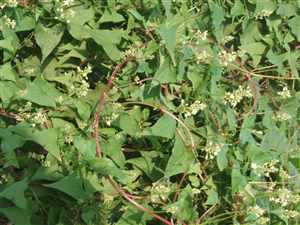Fo-ti (Fallopia multiflora, Polygonum multiflorum), He Shou Wu
Main Facts about Fo-ti

Using Fo-ti
Modern research indicates that this herb contains an alkaloid that has rejuvenating effects on the nerves, brain cells and endocrine glands. It stimulates a portion of the adrenal gland and helps to detoxify the body. The plant is also used as a wash for itching and skin rashes. Another use of the herb is bringing color back to greying hair.Caution!
Extreme overconsumption can lead to liver damage, liver failure, or toxicity-induced hepatitis. Excessive use may also cause gastro-intestinal upset and diarrhea. People with gluten sensitivities should avoid using this product. Do not use while pregnant or breastfeeding. Other drugs that may interact adversely with fo-ti include digoxin, Elavil, Haldol, Inderal, theophylline, Prilosec, Prevacid and Valium.Cooking with Fo-ti
Root is the part of the plant that is used with medicinal purposes. Traditionally, it is boiled with black beans to make a preparation known as red fo-ti. The unprocessed root is known as white fo-ti. Red and white fo-ti are used in different ways and have different curing effects. Edible parts of the plant are leaves, seeds (both consumed raw or cooked) and flowers.How to grow Fo-ti
This plant is native to China and also grows in Japan and Taiwan. The plant prefers acid, neutral and basic soils. It can grow in semi-shade or no shade. It requires moist soil. Growing plants need a lot of protection from the cold during the winter months, and growth is best in well fertilized soil. Seeds are sown in a spring in a cold frame. When they are large enough to handle, prick the seedlings out into individual pots and plant them out in the summer if they have reached sufficient size. It is better to collect and cultivate the plant after 3-4 years of its growth. It is a very fast and aggressive grower and could easily become invasive in warmer climates.| Figwort |
French maritime pine tree
|